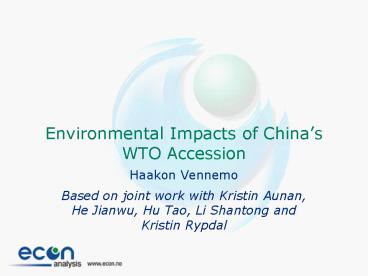Environmental Impacts of China PowerPoint PPT Presentation
1 / 17
Title: Environmental Impacts of China
1
Environmental Impacts of Chinas WTO Accession
- Haakon Vennemo
- Based on joint work with Kristin Aunan, He
Jianwu, Hu Tao, Li Shantong and Kristin Rypdal
2
Background
- A bunch of studies on economic and social impacts
of Chinas WTO accession (e.g., Bhattasali et al,
2004) - A bunch of studies on impacts of free trade on
environment (e.g., Copeland and Taylor, 2004) - But not much on environmental impacts of Chinas
WTO accession
3
Who cares?
- Policy makers in China interested in
environmental impacts - To plan countermeasures
- To plan new policies in the free trade vein
- Donor community interested in encouraging Chinese
interest - And worried that environmental impacts of
accession are negative - Governments, NGOs etc interested in
environmental impacts of freer trade - China an important developing country case study
- Many opinions and qualitative statements, not
many facts and quantitative assessments
4
Free trade in developing countries will
- Increase scale of production, which increases
pollution (scale hypothesis) - Change composition of industries, or attract
dirty industries (composition/pollution haven
hypothesis) - Encourage more efficient technology (technique
hypothesis)
5
And in symbols
- eahs
- eemissions/environmental indicator
- aemission factor (per output) in polluting
industries - hshare of industry that pollutes
- sscale of gdp or similar
- êâhs
- êchange in emissions
- âchange in emission factor/technique
- hchange in share of polluting industries
- schange in scale
6
Key aspects of Chinese WTO-accession
- Before accession there were
- Quotas on imports and exports
- High nominal, but often low effective tariffs
- Processing and traditional trade
- WTO would not make or break the nation
- But a single issue seldom does Among single
issues, WTO has big economic impacts - In addition to political impacts
7
After accession we analyse
- Tariff reduction and quota elimination on
industrial products - Quota elimination on agricultural products
- Quota elimination on textile and apparel exports
(Multifiber agreement)
8
After accession we dont analyse
- Reduction of barriers in service trade (banks and
such) - Increased protection of intellectual property
rights (DVDs and such) - Security of market access (bureaucracy and such)
- Enforcement of commitment
- Cooperation in dispute settlement
9
The model
- Time recursive CGE model with neoclassical
closure - Developed at DRC by Li Shantong et al
- 53 industries, of which 10 agriculture, 29
manufacturing and 6 service - 6 factors of production (3 labour, land, capital,
land, material input) (nested CES) - Saving and consumption (ELES)
- 7 pollutants to air
- 9 health end-points
10
Frictions and distortions
- Imperfect labour and capital mobility between
Guangdong/ROC. - Imperfect labour mobility between urban and rural
occupations - Imperfect mobility between processing and
traditional trade - In addition to direct effect of quotas and
tariffs the impact of WTO depends on its ability
to alleviate above frictions and distortions.
11
Emission block
Traditional pollutants From WB/OECD
calibrated to EDGAR database CH4, N2O
Livestock, fertiliser
12
Results significant industry level change
13
Results Positive composition effect
14
Results one scenario at a time
15
Other impacts
- 1.39 percent increase in GDP
- 0.65 percent improvement in public health
(monetary equivalent) - But baseline cost to public health is only 2.3
percent of GDP. 0.65 of this is small. - Income distribution deteriorates
- Urban households in Guangdong gain 8 percent in
income
16
Further studies
- Sensitivity analysis what matters for results
- Three-region version of model (He Jianwu will
report) - Inclusion of biomass demand
- A means of assessing indoor air issues in
macroeconomic setting - Trade- and environmental policy
- The literature talks about endogenous policy
response
17
ECON Contact information
Oslo ECON Analysis Headquarter/ECON Management
P.O.Box 5, N-0051 OSLO Biskop Gunnerus gate
14A Phone 47 45 40 50 00 Fax 47 22 42 00 40
(Analyse) Fax 47 22 41 41 44
(Management) e-mail oslo_at_econ.no
Stavanger Alex Kiellandsgt. 2 P.O. Box 327
Sentrum N-4002 STAVANGER, Norway Phone 47 45
40 50 00/ 47 51 53 95 66 Fax 47 51
53 95 69 e-mail stavanger_at_econ.no
Stockholm Artillerigatan 42, 5 tr SE-114 45
STOCKHOLM Sweden Phone 46 8 528 01 200 Fax 46
8 528 01 220 e-mail stockholm_at_econ.se
Paris 18, rue de la Perle F-75 003
PARIS France Phone 33 1 45 78 70 03 Fax 33 1
48 87 44 82 e-mail paris_at_econ.no
København Nansensgade 19, 6. sal DK-1366
København K DenmarkPhone 45 33 91 40 45 Fax
45 33 91 40 46 e-mail copenhagen_at_econ.no

